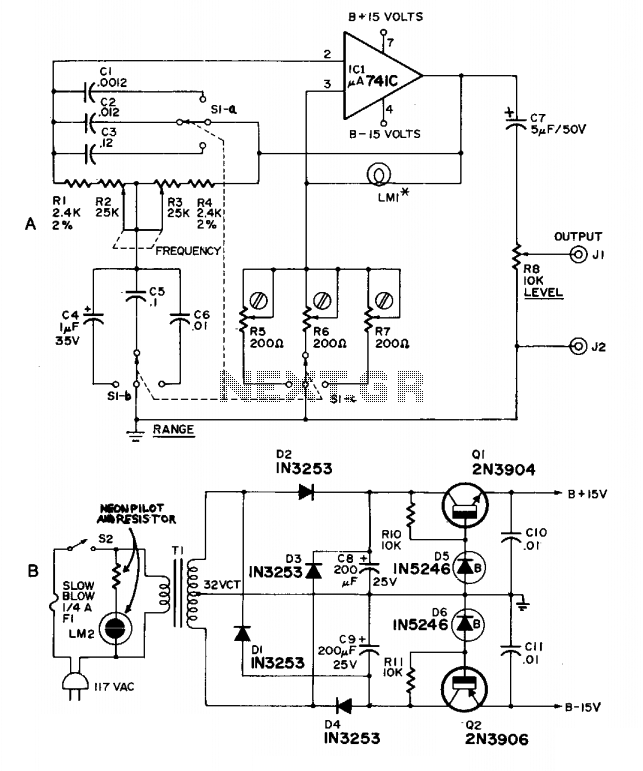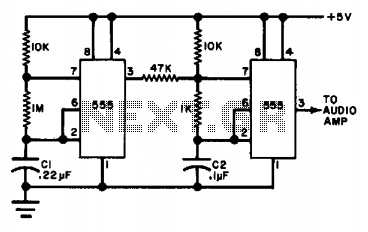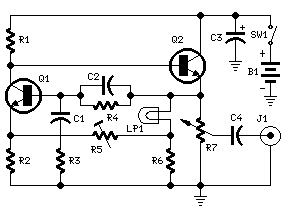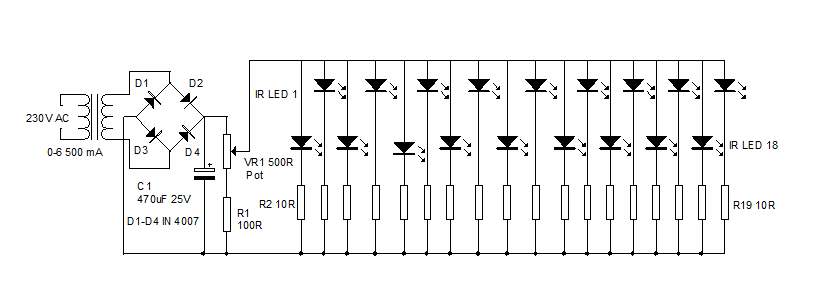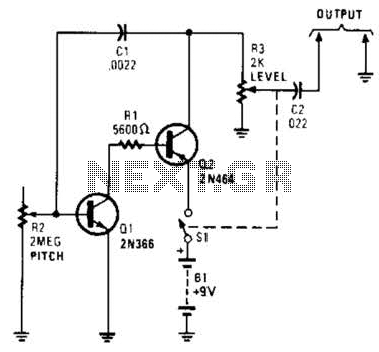
Simple IF Signal Generator
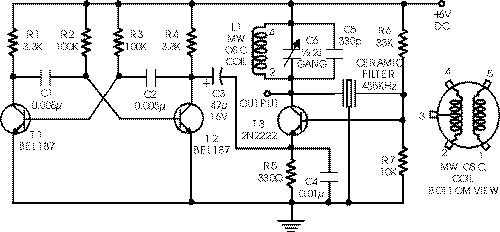
A versatile circuit of an IF signal generator that may be of interest to radio hobbyists and professionals alike. Transistors T1 and T2 form an astable multivibrator oscillating in the audio frequency range of 1 to 2 kHz. An RF oscillator is built around transistor T3, utilizing a 455 kHz ceramic filter/resonator to achieve stable intermediate frequency (IF). The audio frequency (AF) from the multivibrator is coupled from the collector of transistor T2 to the emitter of transistor T3 through capacitor C3. The tank circuit at the collector of transistor T3 is constructed using a medium wave oscillator coil from a transistor radio, a fixed 100 pF capacitor C5, and half of a gang capacitor (C6). The oscillator section can be easily modified for other intermediate frequencies by using a ceramic filter or resonator of the desired frequency and making appropriate changes in the tank circuit at the collector of transistor T3. Slight adjustments to the bias can be made by varying the values of resistors R6 and R7, if necessary.
The described IF signal generator circuit is designed to provide flexibility and adaptability for various radio applications. The astable multivibrator configuration formed by transistors T1 and T2 serves as a reliable source of audio frequency oscillation, operating within the range of 1 to 2 kHz. This multivibrator generates a square wave output, which is essential for modulating the RF signal produced by transistor T3.
Transistor T3 functions as the core RF oscillator, which is essential for generating the intermediate frequency signal. The incorporation of a 455 kHz ceramic filter ensures that the output signal remains stable, which is crucial for maintaining signal integrity in radio applications. The coupling of the AF signal from the collector of T2 to the emitter of T3 through capacitor C3 allows for effective modulation of the RF signal.
The tank circuit, which is pivotal in determining the oscillation frequency of T3, consists of a medium wave oscillator coil, a fixed capacitor (C5), and a portion of a gang capacitor (C6). This arrangement allows for precise tuning and adjustment of the oscillator frequency, facilitating the generation of different intermediate frequencies as required. The ability to modify the circuit for other frequencies by replacing the ceramic filter or resonator, as well as adjusting the tank circuit components, enhances the versatility of the design.
Additionally, the circuit includes resistors R6 and R7, which provide a means for bias adjustment. This feature is particularly useful for fine-tuning the performance of the transistors, ensuring optimal operation within the desired frequency range. Overall, this IF signal generator circuit presents a valuable tool for both amateur and professional radio enthusiasts, offering a robust platform for experimentation and development in RF applications.A versatile circuit of IF signal generator which may be of interest to radio hobbyists and professionals alike. Transistors T1 and T2 form an astable multivibrator oscillating in the audio frequency range of 1 to 2 kHz.
RF oscillator is built around transistor T3. Here again a 455kHz ceramic filter/resonator is employed for obtaining stable IF. The AF from multivibrator is coupled from collector of transistor T2 to emitter of transistor T3 through capacitor C3. The tank circuit at collector of transistor T3 is formed using medium wave oscillator coil of transistor radio, a fixed 100pF capacitor C5 and half section of a gang capacitor (C6).
The oscillator section may be easily modified for any other intermediate frequency by using ceramic filter or resonator of that frequency and by making appropriate changes in the tank circuit at collector of transistor T3. Slight adjustment of bias can be affected by varying values of resistors R6 and R7, if required. 🔗 External reference
The described IF signal generator circuit is designed to provide flexibility and adaptability for various radio applications. The astable multivibrator configuration formed by transistors T1 and T2 serves as a reliable source of audio frequency oscillation, operating within the range of 1 to 2 kHz. This multivibrator generates a square wave output, which is essential for modulating the RF signal produced by transistor T3.
Transistor T3 functions as the core RF oscillator, which is essential for generating the intermediate frequency signal. The incorporation of a 455 kHz ceramic filter ensures that the output signal remains stable, which is crucial for maintaining signal integrity in radio applications. The coupling of the AF signal from the collector of T2 to the emitter of T3 through capacitor C3 allows for effective modulation of the RF signal.
The tank circuit, which is pivotal in determining the oscillation frequency of T3, consists of a medium wave oscillator coil, a fixed capacitor (C5), and a portion of a gang capacitor (C6). This arrangement allows for precise tuning and adjustment of the oscillator frequency, facilitating the generation of different intermediate frequencies as required. The ability to modify the circuit for other frequencies by replacing the ceramic filter or resonator, as well as adjusting the tank circuit components, enhances the versatility of the design.
Additionally, the circuit includes resistors R6 and R7, which provide a means for bias adjustment. This feature is particularly useful for fine-tuning the performance of the transistors, ensuring optimal operation within the desired frequency range. Overall, this IF signal generator circuit presents a valuable tool for both amateur and professional radio enthusiasts, offering a robust platform for experimentation and development in RF applications.A versatile circuit of IF signal generator which may be of interest to radio hobbyists and professionals alike. Transistors T1 and T2 form an astable multivibrator oscillating in the audio frequency range of 1 to 2 kHz.
RF oscillator is built around transistor T3. Here again a 455kHz ceramic filter/resonator is employed for obtaining stable IF. The AF from multivibrator is coupled from collector of transistor T2 to emitter of transistor T3 through capacitor C3. The tank circuit at collector of transistor T3 is formed using medium wave oscillator coil of transistor radio, a fixed 100pF capacitor C5 and half section of a gang capacitor (C6).
The oscillator section may be easily modified for any other intermediate frequency by using ceramic filter or resonator of that frequency and by making appropriate changes in the tank circuit at collector of transistor T3. Slight adjustment of bias can be affected by varying values of resistors R6 and R7, if required. 🔗 External reference

